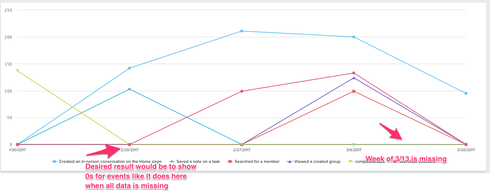Insert zeros when usage is missing on a weekly trending report
None
I wasn't able to find a similar community post (apologies if this exists already). We've recently come across this issue with Cisco and a few other customers. When there is no data for a time period, that date period is removed from the report and it's connected to the next available date. We'd like the ability to display the missing dates as Zeros to provide an accurate view into the usage. This creates a more consistent experience for the end users. I've provided 2 customer scenarios below.
Cisco Use Case:
Trend view on R360 only displays months where data is processed, creating jumps in the timeline and it's not clear to CuSMs when there are months where there were not any scores for that particular month.
Customer #2 Use Case:
Customer2 is using our Segment connector - when there is no usage in a given week, the customer doesn't display any data (common use case). Given the volume of data they are sending us for various events, we'd want to avoid the workaround of inserting zeros for every data point that is missing for that week. Here is an example of a report where data is missing for a few weeks.
Does anyone else have use cases to share? Are there any workarounds that you've used that don't require inserting zero?
Are there any plans to address this with product?
Cisco Use Case:
Trend view on R360 only displays months where data is processed, creating jumps in the timeline and it's not clear to CuSMs when there are months where there were not any scores for that particular month.
Customer #2 Use Case:
Customer2 is using our Segment connector - when there is no usage in a given week, the customer doesn't display any data (common use case). Given the volume of data they are sending us for various events, we'd want to avoid the workaround of inserting zeros for every data point that is missing for that week. Here is an example of a report where data is missing for a few weeks.
Does anyone else have use cases to share? Are there any workarounds that you've used that don't require inserting zero?
Are there any plans to address this with product?
Sign up
If you ever had a profile with us, there's no need to create another one.
Don't worry if your email address has since changed, or you can't remember your login, just let us know at community@gainsight.com and we'll help you get started from where you left.
Else, please continue with the registration below.
Welcome to the Gainsight Community
Enter your username or e-mail address. We'll send you an e-mail with instructions to reset your password.




So in this case then with the initial post, we're really looking to see trends in reports where no data exists for a given week.
If the purpose of creating a graph is for fast visual consumption of a data set, and we simply drop out the weeks on the X-axis where there was no usage, we're creating a misleading visual. Unless I look closely at a 24-month graph that had no usage during 2 months, I'll probably assume that usage has been steady for 2 years.
However we do it, we want to get away from writing 0's to fields with rules engine -- ultimately, there IS a difference between 0 and NULL -- and when looking at tables, we want to preserve that. When graphing over time, though, we should treat it like any other incremented X-axis in graphing - retain each increment to show what happened during that month, or week, or day.
Guessing that this has fallen off the radar a little since we haven't been pushing it - is this something that's in our backlog? Something before end of calendar year?
From a purely geometric standpoint, some value must be assigned if we create an x-axis point for date, correct? The only geometric equivalent for absence of data (null) is zero. Or is there something that I'm missing here?
Or is it just that you want to know the difference between these two scenarios (using Kendra's original use case of a Segment connection):
* Segment sent no data for the specified date
* Segment sent data for the specified date and the data it sent was zero
?